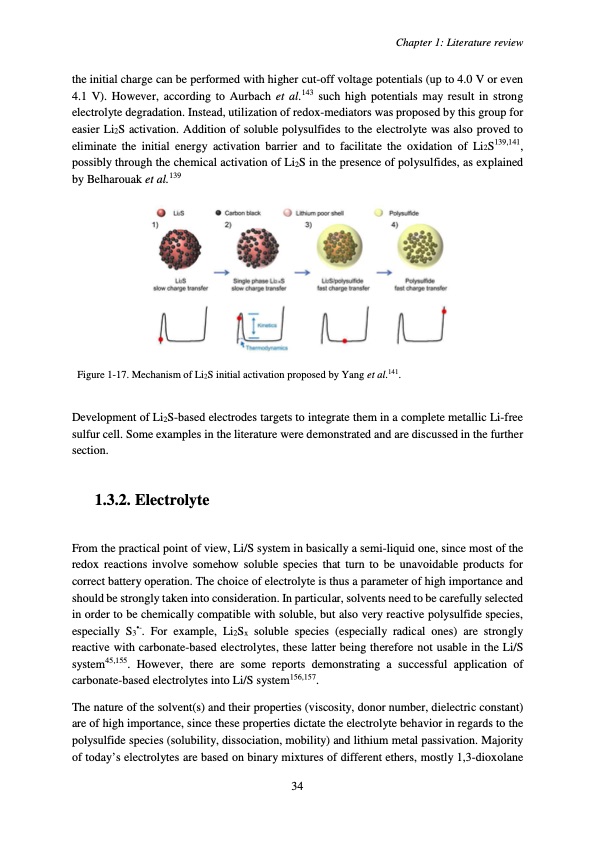
PDF Publication Title:
Text from PDF Page: 038
the initial charge can be performed with higher cut-off voltage potentials (up to 4.0 V or even 4.1 V). However, according to Aurbach et al.143 such high potentials may result in strong electrolyte degradation. Instead, utilization of redox-mediators was proposed by this group for easier Li2S activation. Addition of soluble polysulfides to the electrolyte was also proved to eliminate the initial energy activation barrier and to facilitate the oxidation of Li2S139,141, possibly through the chemical activation of Li2S in the presence of polysulfides, as explained by Belharouak et al.139 Figure 1-17. Mechanism of Li2S initial activation proposed by Yang et al.141. Development of Li2S-based electrodes targets to integrate them in a complete metallic Li-free sulfur cell. Some examples in the literature were demonstrated and are discussed in the further section. 1.3.2. Electrolyte From the practical point of view, Li/S system in basically a semi-liquid one, since most of the redox reactions involve somehow soluble species that turn to be unavoidable products for correct battery operation. The choice of electrolyte is thus a parameter of high importance and should be strongly taken into consideration. In particular, solvents need to be carefully selected in order to be chemically compatible with soluble, but also very reactive polysulfide species, especially S3•-. For example, Li2Sx soluble species (especially radical ones) are strongly reactive with carbonate-based electrolytes, these latter being therefore not usable in the Li/S system45,155. However, there are some reports demonstrating a successful application of carbonate-based electrolytes into Li/S system156,157. The nature of the solvent(s) and their properties (viscosity, donor number, dielectric constant) are of high importance, since these properties dictate the electrolyte behavior in regards to the polysulfide species (solubility, dissociation, mobility) and lithium metal passivation. Majority of today’s electrolytes are based on binary mixtures of different ethers, mostly 1,3-dioxolane Chapter 1: Literature review 34PDF Image | Accumulateur Lithium Soufre

PDF Search Title:
Accumulateur Lithium SoufreOriginal File Name Searched:
WALUS_2015_archivage.pdfDIY PDF Search: Google It | Yahoo | Bing
Sulfur Deposition on Carbon Nanofibers using Supercritical CO2 Sulfur Deposition on Carbon Nanofibers using Supercritical CO2. Gamma sulfur also known as mother of pearl sulfur and nacreous sulfur... More Info
CO2 Organic Rankine Cycle Experimenter Platform The supercritical CO2 phase change system is both a heat pump and organic rankine cycle which can be used for those purposes and as a supercritical extractor for advanced subcritical and supercritical extraction technology. Uses include producing nanoparticles, precious metal CO2 extraction, lithium battery recycling, and other applications... More Info
| CONTACT TEL: 608-238-6001 Email: greg@infinityturbine.com | RSS | AMP |